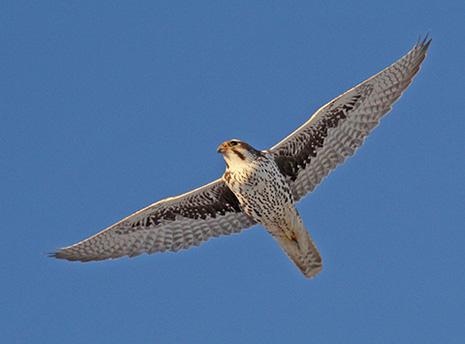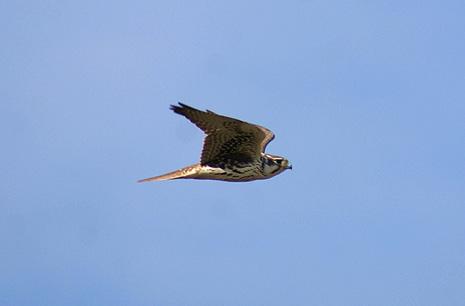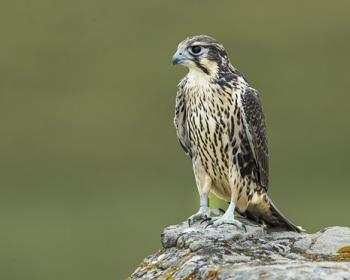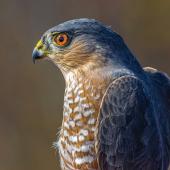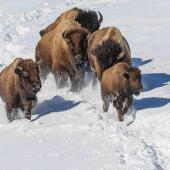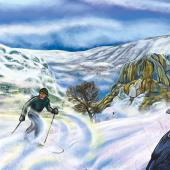Winged Pursuit
All about the prairie falcon.
Often, it is the charismatic and spectacular that draws people to nature. When wildlife is depicted onscreen for example, we’ll usually see images of large mammals and skillful predators; bears, wolves, lions, bison, elk, all doing their thing amidst some gorgeous and wild landscape. Birding is no different, with raptors garnering much of the public’s awe and attention. This shouldn’t be surprising: hawks, owls, and eagles are majestic predators that have been honored by human cultures for millennia, appearing in art, literature, and oral histories. For many birders though, it is the falcons that hold a special place among birds of prey.
There are five falcon species regularly observed in Montana; gyrfalcon (winter only), American kestrel, merlin, peregrine, and the prairie falcon. These birds can be differentiated from hawks and others in flight by their strongly tapered wings that terminate in a point, an adaptation which serves a single evolutionary purpose: speed. The falcons are well-known as the fastest animals on earth, and one in particular, is uniquely tied to the American West.
Prairie Falcons (Falco mexicanus) live solely in the Americas, ranging from northern Mexico to southern Canada, inhabiting huge swaths of the Great Plains. The bird is a medium-large raptor with dark underwing coverts, which when viewed from below, appear as very distinctive “dark armpits” and is their most reliable field mark. Its overall brownish appearance is an adaptation to the vast deserts, sage, and grassland environments where it is most commonly found. They are also capable of using high alpine meadows and tundra habitat provided food resources are adequate.
Many of these raptors are year-round residents of their breeding ranges, but some will make short-distance migrations if food availability requires it. Male and female markings are virtually identical, but as with most birds of prey, the females are significantly larger. Rocky cliffs and outcrops are used as nest sites. Genetic analysis has shown that the prairie falcon is a fairly close relative to the better known peregrine falcon. A split began about 3-5 million years ago as evolutionary pressures honed an ancestral peregrine to adapt to the open, dry landscapes of the West. The two species will occasionally interbreed where they overlap.
Arid ecosystems are unforgiving, difficult places to make a living for any creature and require special adaptations for survival. In these low prey-base environments, a smaller, lighter body enables the prairie falcon to get by on fewer calories more efficiently than raptors of similar size, while also allowing them to be more heat-tolerant than a bulkier bird. They use a variety of hunting styles including the well-known “stoop” (rapid diving attack) on airborne bird prey; a fast, low-altitude ground cruising tactic; or a line-of-sight ambush from high perches. The bird has evolved to become an especially aggressive and opportunistic hunter and will swiftly attack anything from grasshoppers and sparrows to an array of rodents, to creatures as large as a goose or greater sage grouse. All have been taken by the nimble prairie falcon, which are also known to cache excess food as a hedge against lean times.
The hunting prowess of this raptor was impressed upon me while guiding a birding workshop several years ago. We arrived at an area of wetland and prairie midmorning, and began to scan for grassland species. A few nighthawks and Wilson’s snipe immediately drew our attention, but before long, a frantic, persistent calling from somewhere in the grass dominated the morning soundscape. After a few moments of listening and searching, members of the group were able to zero in on the culprits; about 50 yards from us was a pair of marbled godwits, both birds freaking out, alarm calling and trying to corral about four chicks which were difficult to see due to their tawny camouflage.
We scanned the area but saw nothing that should have set these birds into such a tizzy, so we slowly approached them for a better look. One adult flew to a nearby fencepost, and the other stayed close to the chicks and what may have been their nesting area. All of these godwits were on high-alert and it was clear that they weren’t reacting to our presence but something else. I began to look for the cause and glassed a low sandstone ridge a few hundred yards away. Bingo: a prairie falcon, nearly invisible, was perched on a small rocky outcrop and seemed barely interested in the whole affair. Scopes were set on the bird and our group studied it for a few minutes while the godwits continued their disturbing alarm calls.
After a time, this prairie falcon had had enough: it quickly focused its gaze toward the sound, raised its wings, and shot from the ridge in what was probably the fastest movement I have ever witnessed in nature. Hitting the nest in the virtual blink of an eye, the falcon instantly removed one of the chicks while human birders stood in awe, eyes and mouths wide open. Some in the group were visibly disturbed by this unvarnished act of predation. Alas, it is what makes the world go around in nature, everywhere, all the time.
In this case, a bad morning for marbled godwits meant a good one for prairie falcons.
This column, written by David Cronenwett, orginally appeared on mtaududon.org. Montana Audubon is an independent, statewide wildlife conservation organization. Cronenwett is a writer, naturalist, and Audubon staff member who can be reached at [email protected].



